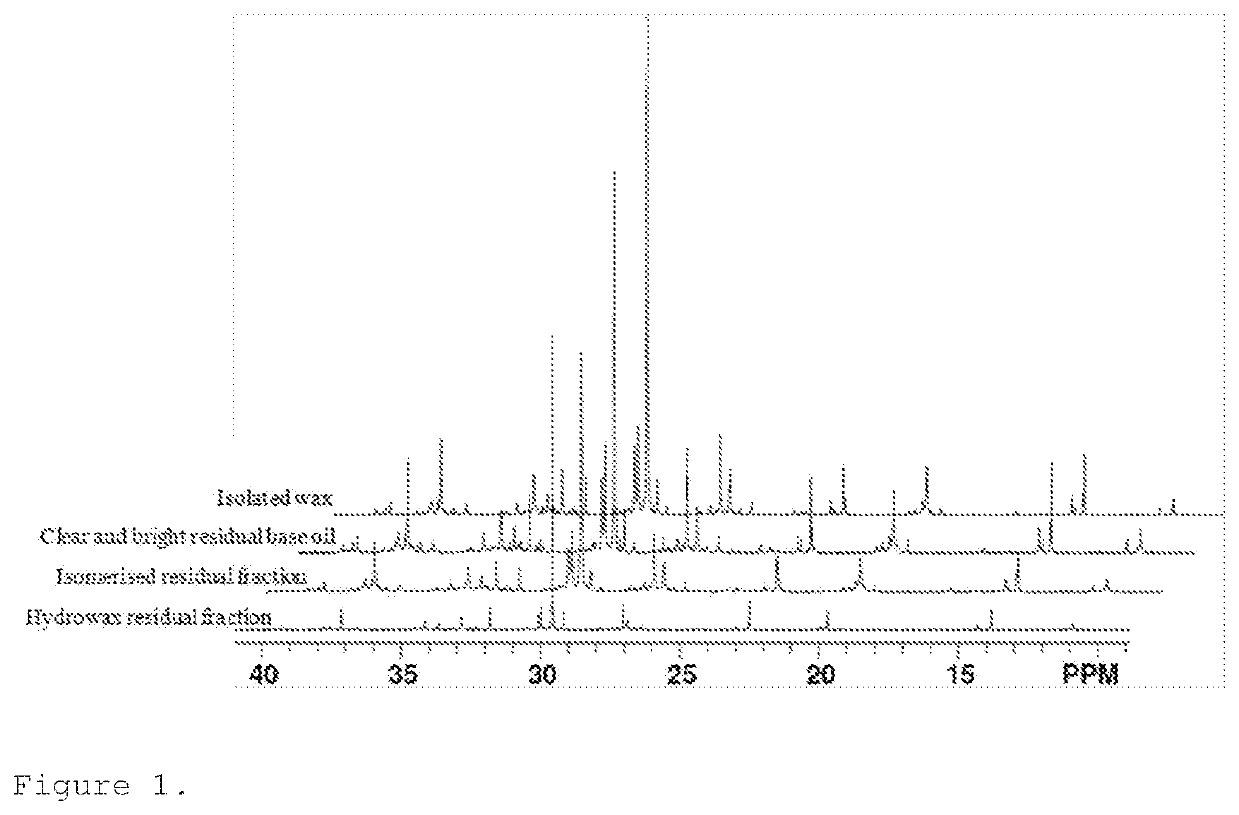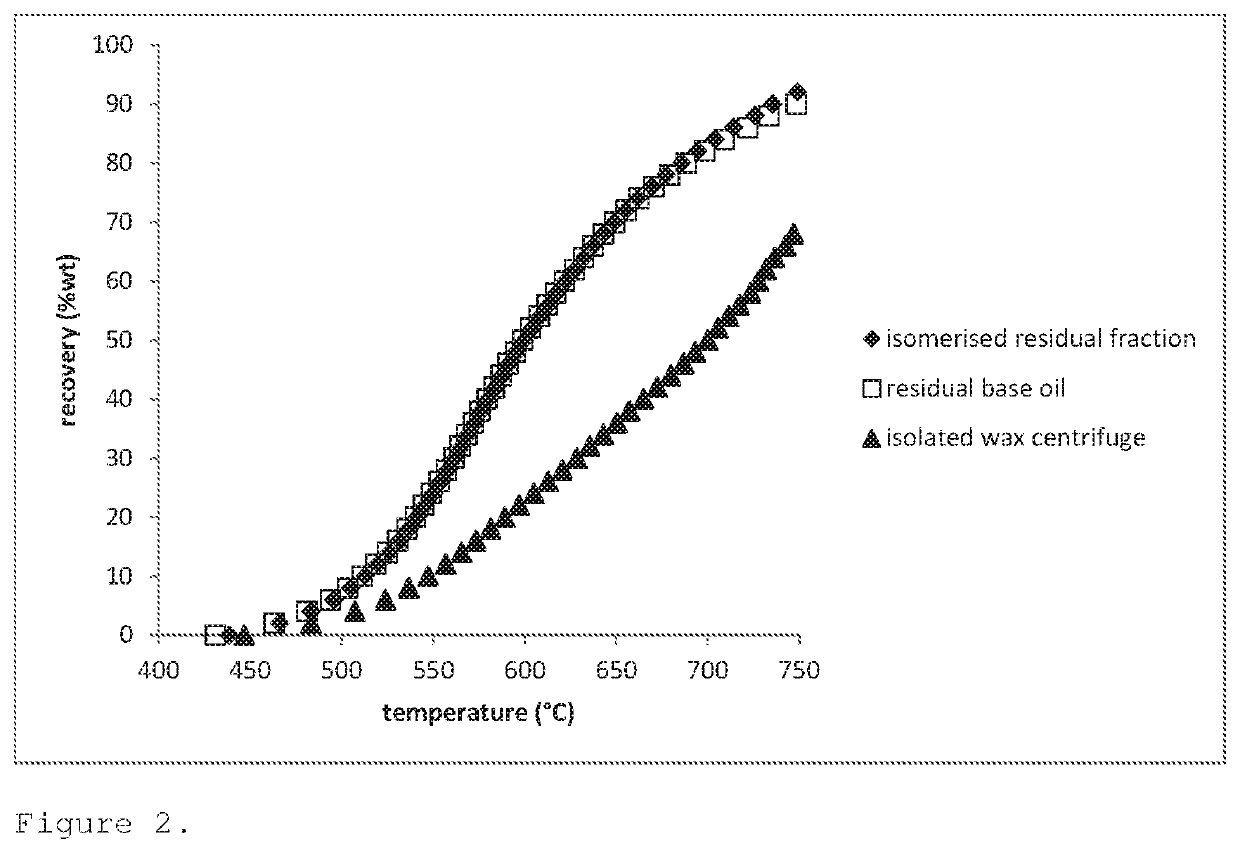Residual base oil process
a residual base oil and process technology, applied in the direction of hydrocarbon oil treatment products, base materials, lubricant compositions, etc., can solve the problems of undesirable appearance of residual ft base oils, adversely affecting the filterability of oils, etc., and achieve the effect of reducing the hazy appearance of waxy haze in ft residual base oils
- Summary
- Abstract
- Description
- Claims
- Application Information
AI Technical Summary
Benefits of technology
Problems solved by technology
Method used
Image
Examples
example 1
Use of Centrifuging to Prepare and Obtain Hydrowax Residue, Isomerized Residual Fraction, Isolated Wax and Clear and Bright Residual Base Oil
[0047]From a Fischer Tropsch derived hydrocarbon feed, through a hydrocracking step (60 bar, 330-360° C.) and subsequent atmospheric and vacuum distillation a vacuum hydrowax residue was obtained (congealing point=103° C.). This vacuum hydrowax residue (HVU bottom) was subjected to a catalytic dewaxing step and subsequent distillation. The isomerized residual fraction, with a density of D70 / 4=0.805, a kinematic viscosity according to ASTM D445 at 100° C. of 21.2 mm2 / s, a pour point of PP=−24° C. and a cloud point of cp=42° C., was mixed with Petroleum Ether 40 / 60) in a ratio of 2 parts by weight of diluent to 1 part by weight of isomerized residual fraction. The diluted isomerized residual fraction was cooled to a temperature of −30° C. The cooled diluted isomerized residual fraction was exposed to a high rotation speed of 14000 RPM (equivalent...
example 2
Using Solvent Dewaxing to Prepare and Obtain Hydrowax Residue, Isomerized Residual Fraction, Isolated Wax and Clear and Bright Residual Base Oil
[0048]From a Fischer Tropsch derived hydrocarbon feed, through a hydrocracking step (60 bar, 330-360° C.) and subsequent atmospheric and vacuum distillation a vacuum hydrowax residue was obtained (congealing point=103° C.). This vacuum hydrowax residue (HVU bottom) was subjected to a catalytic dewaxing step and subsequent distillation. The isomerized residual fraction, with a density of D70 / 4=0.805, a kinematic viscosity according to ASTM D445 at 100° C. of 21.2 cSt, a pour point of PP=−24° C. and a cloud point of cp=42° C., was mixed with Heptane / Methyl Ethyl Ketone 50 / 50 weight percentage in a ratio of 4 parts by weight of diluents to 1 part by weight of isomerized residual fraction. The diluted isomerized residual fraction was heated to dissolve the wax and subsequently cooled to a temperature of −25° C. at a rate of 1° C. per minute. The...
example 3
13C-NMR Spectroscopy
[0049]Quantitative 13C and APT (Attached Proton Test) NMR spectra were recorded using an Agilent 400 MHz spectrometer equipped with a 5 mm probe. To prepare NMR samples, approximately 25 wt % solution of isomerised residual fraction, clear and bright residual oil and wax isolated by centrifugation were prepared in deuterated chloroform solvent. The NMR sample of wax isolated via solvent extraction contained 13 wt % solution in CDCl3. Spectra of these four samples were acquired at 40° C. To prepare an NMR sample of the hydrowax residual fraction, a small amount was scooped and dissolved in deuterated tetrachloroethane. To keep this sample in a liquid state, the temperature in the NMR spectrometer was raised to 120° C. All NMR samples for a quantitative analysis contained tris(acetylacetonato) chromium (III), which acted as a relaxation agent to induce the spin-lattice relaxation and reduce therefore T1 relaxation time. Between 22000 and 10000 scans were acquired d...
PUM
| Property | Measurement | Unit |
|---|---|---|
| cloud point | aaaaa | aaaaa |
| kinematic viscosity | aaaaa | aaaaa |
| cloud point | aaaaa | aaaaa |
Abstract
Description
Claims
Application Information
 Login to View More
Login to View More - R&D
- Intellectual Property
- Life Sciences
- Materials
- Tech Scout
- Unparalleled Data Quality
- Higher Quality Content
- 60% Fewer Hallucinations
Browse by: Latest US Patents, China's latest patents, Technical Efficacy Thesaurus, Application Domain, Technology Topic, Popular Technical Reports.
© 2025 PatSnap. All rights reserved.Legal|Privacy policy|Modern Slavery Act Transparency Statement|Sitemap|About US| Contact US: help@patsnap.com



